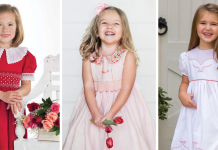
Text by AMELIA JOHANSON / Photography by JENNIFER TARKINGTON and MAC JAMIESON
If ever there was an heirloom sewing masterpiece, this beautiful gown designed by Connie Palmer is it. This new dress made from vintage handkerchiefs will be passed down for generations.
After the Cuban Revolution of 1959, professionals and their families left Cuba for the U.S. fearing reprisal from the newly minted dictator, Fidel Castro. By 1962, when air flights between the two countries were suspended, nearly 200,000 Cuban exiles had fled(1), and most, like Maria Graham (née Martinez), her sister, and grandparents, had landed in South Florida. Her parents and brother would follow, and in her mother’s luggage, a family treasure.
According to Maria’s accounts, shortly before her departure, her family’s entire neighborhood had been taken over by the military, and everyone had to be searched coming in and out of the area. Her father, a dentist, had gone out of his way to befriend many of the soldiers.
“Whenever he was searched, he would hand them a business card and tell them, ‘If you have a toothache, call me. I’ll take care of it at no cost,’ ” recalled Maria.
That small gesture probably ended up saving their lives. One evening, the children were home with their nanny when soldiers banged on the door and entered for an impromptu search. When they’d made it to a locked closet where her parents had secured what would have been considered propaganda and firearms for the resistance, the children and their nanny simply pretended they didn’t know that it was locked.
“As the soldiers were getting ready to break down the door, my father and mother arrived home for the evening,” said Maria. “One of the soldiers looked at my father and said, ‘Oh, this is Dr. Martinez’s house. We don’t need to be searching here.’ It was very tense, and the soldiers started to argue with each other about what to do, but eventually they all left.”
Many friends of the Martinez family had ended up in jail from such searches, and understanding just how close they had come to a similar fate, Dr. Martinez set plans in motion for the family to leave Cuba. Arrangements were first made for Maria and her sister, who were 6 and 8 at the time. The Communist Party didn’t have much use for young children or those who were retired, according to Maria, so the two flew with their paternal grandparents for a “vacation” in the states. Her father, mother, and 10-year-old brother, Mario, were forced to remain behind. Under Castro’s regime, boys who had reached that age were being taken from their families and placed into training and indoctrination camps for the socialist state. Mario, however, had been blind from birth, so Dr. Martinez wrote to a Boston ophthalmologist they had previously sought for treatment, “reminding” him that it was time for Mario’s eyes to be checked.
“He was hoping the doctor would read between the lines and provide a reason for my parents and brother to leave Cuba,” said Maria.
The doctor appeared to get the message, and once Maria’s father had an appointment letter in hand and could show it to the Communist Party, he was able to secure the visas they needed. Three months after Maria and her sister left Cuba, the family was reunited in Miami. “We were only allowed to take 70 pounds of luggage per person when we left, because you couldn’t say you were leaving the country for good,” said Maria. “We mostly took clothing, but my mother, Carmelina, also packed (a collection of) handmade handkerchiefs, which tells you how important they were to her. She chose those handkerchiefs over other things so as not to go over the 70 pounds.”
 The handkerchiefs were cotton, linen, and silk pieces Carmelina had as a young girl. Some had been passed down from her mother, Fela Ros y Caballero; others she had stitched herself. Each was handmade and some very detailed; several were monogrammed with her initials or full name. She kept them wrapped in tissue paper in a special box, and once or twice a year, Maria and her sister would pull them out and go through them.
The handkerchiefs were cotton, linen, and silk pieces Carmelina had as a young girl. Some had been passed down from her mother, Fela Ros y Caballero; others she had stitched herself. Each was handmade and some very detailed; several were monogrammed with her initials or full name. She kept them wrapped in tissue paper in a special box, and once or twice a year, Maria and her sister would pull them out and go through them.
“My mother would only let us do that for so long before she’d say, ‘You need to put those away now. They’re over 100 years old,’ and we would put them away until the next time.”
After both Maria’s parents and her uncle passed away, she became the unofficial keeper of the family mementos. She put all the family birth and death certificates, diplomas, and photographs that had survived Cuba in albums, and when she was finished, she was left with the handkerchiefs, still wrapped in tissue in their special box.
“I wanted to do something with them that was worthy of my family’s history,” Maria said. “I already had several grandchildren when the idea came to mind, but Eva Marie, my youngest grandchild, had not yet been baptized.”
Enter Martha Pullen. As fate would have it, the Martinez family eventually settled in Birmingham, Alabama, where her father re-enrolled in dental school in order to practice in this country. Once he graduated, he remained on the faculty for nearly 40 years and taught both Martha’s husband, Joe, and her stepson, Mark, in Oral Pathology. Maria found her way to Huntsville, Alabama, the original home of Martha Pullen Company, after marrying her husband, who was also an orthodontist in the community. Maria knew that if anyone could help her figure out how to turn her precious and priceless handkerchiefs into a baptismal gown, it would be Martha. It only took one instant message through Facebook to generate Martha’s excitement and energy for the project. Once Maria was able to show her the handkerchiefs, Martha told her there was only one person in the world she’d trust to design a gown around them—Connie Palmer. In a matter of weeks, Connie was carefully going through the box of handkerchiefs picking and choosing which ones she felt would work for the gown she wanted to create.
“I didn’t use any of the silk ones or those that had colored embroidery,” Connie said. “Everything I used was white-on-white, or ecru-on-white. A few had Madeira, others had hand embroidered names or initials. I just tried to pick as many out of her box that would coordinate.”
Connie also knew that she’d be cutting into the precious mementos, using a corner of one here, a corner of another there. She was charged with determining how to use each one without destroying the integrity of the original handwork, and without, as Connie quipped, the dress presenting like, “Oh, look, she has a ruffle full of hankies.”
She selected white Swiss batiste to use for the body of the dress and a trim of non-matching, ecru antique laces—yardage she had received from Martha years ago.
“The laces weren’t a series. I like to mix them up, because I think when you just use a series (laces designed to match), it can be so boring,” she said. “And when you look at antique gowns, you often don’t see a whole series of laces; they used what they had, and so I used what I had.”
She started by gingerly washing each handkerchief and then planning the design, ever cognizant of that fact that if she made a mistake, if she cut something wrong, it couldn’t be replaced.
“Everything else I had made to this point I could replace if I messed up. I could get a new piece of fabric or buy more lace,” she said. “I know I put more into (this gown) than what I was commissioned to do, but my whole life has been about doing a good job. This was history—it wasn’t monetary. It was just as much a gift to me, because I’d never been asked to do anything like it.”
She started with a basic yoke bodice pattern and cut both the yoke and sleeve overlays from handkerchiefs. She built the skirt in several panels framed in lace insertion. Within the panels, she added lace-shaped bows. At the bottom, she joined the handkerchiefs set on point and finished the hem in softly gathered edging. Underneath the gown extends a gorgeous embellished slip, complete with a fancy band of French lace and a ruffle of deep Swiss edging with a tiny scalloped finish to which Connie added pintucks, insertion, featherstitching, and a French lace edge. On the body of the slip, Connie embroidered a Bible verse along with the family’s history, which included various dates and names related to the Martinez family and the story of the handkerchiefs.
“It was very emotional for me, because I knew the history behind it,” said Connie, who worked over two months to complete the gown. “I would just look at it sometimes and start crying, thinking, ‘I’m weaving the history of this family together.’ ”
The circumstances under which the Martinez family left Cuba were tragic, and Maria believes deeply that anything that made it over to America made it over for a reason. She wanted to make sure her grandmother’s handkerchiefs were honored. The Martinez baptismal gown will always hold an extra element of sentimental value. It’s quite simply, priceless.
Eva Marie was baptized June 2, 2019, at Holy Spirit Catholic Church in Huntsville, Alabama.






